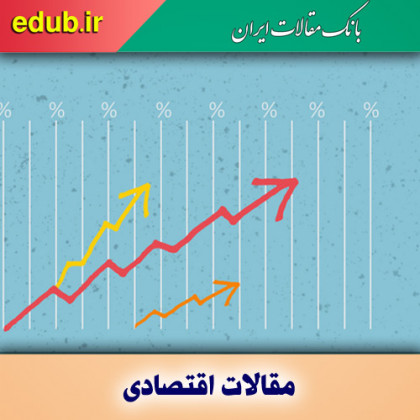مقاله اثر تغییر ساختار سنی جمعیت بر تورم در اقتصاد ایران

مقاله علمی و پژوهشی " اثر تغییر ساختار سنی جمعیت بر تورم در اقتصاد ایران" مقاله ای است در 62 صفحه و با 17 فهرست منبع که در مجلات معتبر علمی و پژوهشی با رویکرد اقتصاد و الگو سازی منتشر شده است
در این مقاله علمی و پژوهشی به مباحث تورم؛ ساختار سنی جمعیت؛ فرضیة دوران زندگی؛ همجمعی؛ الگوی خودرگرسیون گسترده وقفه(ARDL) پرداخته شده است
چکیده مقاله
انفجار جمعیتی دهة 60، امروز جمعیت جوانی را در اختیار کشور قرار داده که عمدتاً در گروه-های سنی 20 تا 29 سال قرار گرفته¬اند. براساسفرضیة دورانزندگیآندو-مادیگلیانی چنانچه توزیع سنی جمعیت یک کشور در حول و حوش گروه¬های سنی خاصی قرار گیرد، مصرف کل جامعه متأثر از این گروه¬های غالب خواهد بود. از طرفی تغییر در مصرف کل جامعه، تقاضای کل را تحت تأثیر قرار خواهد داد و آنگاه با استناد به نظریة فشار تقاضای کینز این مسئله می¬تواند سبب تغییر در قیمت¬ها و بروز تورم شود. از اینرو این مقاله درصدد است با تلفیق دو نظریة فوق به بررسی و تحلیل اثر تغییر در ساختار سنی جمعیت بر تورم در اقتصاد ایران بپردازد.
بدین منظور با استفاده از اطلاعات سری¬های زمانی مربوط به دورة 1386-1338 و با تکیه بر تکنیک¬های همجمعی و روش خودرگرسیون¬گسترده¬وقفه (ARDL) به برآورد الگوی تورم پرداخته شده است. نتایج مؤید آن است که ساختار سنی جمعیت عاملی تأثیرگذار بر تورم در اقتصاد ایران است. یک افزایش در نسبت جمعیت واقع در گروه¬های سنی 15 تا 24 سال و 55 سال به بالا سبب افزایش تورم و یک افزایش در نسبت جمعیت واقع در سنین 25 تا 54 سال سبب کاهش تورم خواهد شد. از طرفی گروه¬های سنی 39-35 و 44-40 سال به ترتیب بیشترین اثر را بر کاهش تورم دارند.
با توجه به نتایج بهدست آمده می¬توان انتظار داشت که طی سال¬های آینده با وارد شدن جمعیت جوان حال حاضر کشور به گروه¬های سنی بالاتر، به تدریج فشارهای تورمی از جانب جمعیت کاسته شده و تورم روندی نزولی را در پیش گیرد.
عنوان مقاله [English]
Population Age Structure and Inflation in Iran
چکیده [English]
Rapid population expansion of the early 1360s has now provided a young labor force who are mainly in the 20 to 29 years of age. According to the Life Cycle Hypothesis of Ando & Modigliani, if the age distribution of population of a country centers around a special age group, total consumption of the society would be affected by this dominate group. On the other hand, changes in total consumption will affect aggregate demand. Based on the Demand-pull’s theory of Keynes, This issue can cause change in prices and inflation. Keeping in mind these two stories, this paper is going to analyze the effect of population age structure change on the price level and inflation in the Iranian economy.
For this purpose, an inflation model is constructed which incorporated the age distribution of population. Using annual time series data within the period 1338 and 1386 and utilizing Co-integration techniques and Auto Regressive Lag (ARDL) method, the inflation model has been estimated. The results indicate that the age structure of population is an effective factor on inflation in the Iranian economy. A relative population increase in the age group of 15-24 and 55 years and over, tend to result in higher inflation, while a relative increase in population within the age group of 25-29, 30-34,…and 50-54 years has a negative impact on inflation. On the other hand the age groups of 35-39 and 40-44 years have the highest effect on disinflation.
Considering the obtained results, during the economy years when the currently young population of the country moves to the higher age group, it can be expected that inflationary pressure gradually is reduced and inflation moves along a descending trend.
کلیدواژهها [English]
Inflation, Population Age Structure, Life Cycle Hypothesis, Co-integration, Auto Regressive Lag (ARDL)
دانشجویان دوره دکترا و کارشناسی ارشد می تواند از محتوای این مقاله برای رساله دکترا و پایان نامه کارشناسی ارشد بهره ببرند .
مطالب مرتبط
-
 تورم به کدام سو میرود؟
تورم به کدام سو میرود؟
-
 معرفی کتاب قدرت خلق کسب و کار نوپا
معرفی کتاب قدرت خلق کسب و کار نوپا
-
 مقاله تاثیر تمرین بدنی و ذهنی بر یادگیری حرکتی دانش آموزان عقب ماندة ذهنی آموزش پذیر
مقاله تاثیر تمرین بدنی و ذهنی بر یادگیری حرکتی دانش آموزان عقب ماندة ذهنی آموزش پذیر
-
 مقاله مقایسه تطبیقی نظریه محقق طوسی و علامۀ حلّی در معاد جسمانی با نظریه شبیهسازی
مقاله مقایسه تطبیقی نظریه محقق طوسی و علامۀ حلّی در معاد جسمانی با نظریه شبیهسازی
-
 مقاله نقش انگیزش بیرونی و درونی در گرایش بزرگسالان به فعالیت جسمانی
مقاله نقش انگیزش بیرونی و درونی در گرایش بزرگسالان به فعالیت جسمانی
-
 مقاله تأثیر بازی های کودکانة سنتی و مدرن بر رشد اجتماعی دانش آموزان
مقاله تأثیر بازی های کودکانة سنتی و مدرن بر رشد اجتماعی دانش آموزان
-
 مقاله تاثیر مدل های مختلف تصویرسازی بر تعادل دانشجویان دختر دانشگاه تهران
مقاله تاثیر مدل های مختلف تصویرسازی بر تعادل دانشجویان دختر دانشگاه تهران
-
 مقاله کاربرد اصل تشکیک در معاد جسمانی از دیدگاه ملاصدرا
مقاله کاربرد اصل تشکیک در معاد جسمانی از دیدگاه ملاصدرا
تگها
مطالب پربیننده
- سئوالات و پاسخنامه آزمون دکترای مهندسی صنایع سال ۱۴۰۳
- سئوالات و پاسخنامه آزمون دکترای مهندسی پزشکی سال ۱۴۰۳
- سئوالات و پاسخنامه آزمون دکترای مهندسی مکانیک (2) سال ۱۴۰۳
- سئوالات و پاسخنامه آزمون دکترای مهندسی مکانیک (1) سال ۱۴۰۳
- سئوالات و پاسخنامه آزمون دکترای مهندسی نقشه برداری سال ۱۴۰۳
- سئوالات و پاسخنامه آزمون دکترای مهندسی عمران سال ۱۴۰۳
- سئوالات و پاسخنامه آزمون دکترای مهندسی برق سال ۱۴۰۳
- سئوالات و پاسخنامه آزمون دکترای علوم شناختی سال ۱۴۰۳
- سئوالات و پاسخنامه آزمون دکترای علوم کامپیوتر و بیوانفورماتیک سال ۱۴۰۳
- سئوالات و پاسخنامه آزمون دکترای ژئوفیزیک سال ۱۴۰۳
- سئوالات و پاسخنامه آزمون دکترای فیزیک سال ۱۴۰۳
- سئوالات و پاسخنامه آزمون دکترای ریاضی سال ۱۴۰۳
- سئوالات و پاسخنامه آزمون دکترای آمار سال ۱۴۰۳
- سئوالات و پاسخنامه آزمون دکترای آموزش زبان و ادبیات انگلیسی سال ۱۴۰۳
- سئوالات و پاسخنامه آزمون دکترای بیوشیمی سال ۱۴۰۳
- سئوالات و پاسخنامه آزمون دکترای شهرسازی سال ۱۴۰۳
- سئوالات و پاسخنامه آزمون دکترای معماری سال ۱۴۰۳
- سئوالات و پاسخنامه آزمون دکترای مدرسی معارف اسلامی سال ۱۴۰۳
- سئوالات و پاسخنامه آزمون دکترای علوم ارتباطات سال ۱۴۰۳
- سئوالات و پاسخنامه آزمون دکترای حسابداری سال ۱۴۰۳
- سئوالات و پاسخنامه آزمون دکترای گردشگری سال ۱۴۰۳
- سئوالات و پاسخنامه آزمون دکترای حقوق سال ۱۴۰۳
- سئوالات و پاسخنامه آزمون دکترای مدیریت سال ۱۴۰۳
- سئوالات و پاسخنامه آزمون دکترای علم اطلاعات و دانش شناسی سال ۱۴۰۳
- سئوالات و پاسخنامه آزمون دکترای روانشناسی ۲ سال ۱۴۰۳
- سئوالات و پاسخنامه آزمون دکترای سنجش و اندازه گیری سال 1403
- سئوالات و پاسخنامه آزمون دکترای روانشناسی سال 1403
- سئوالات و پاسخنامه آزمون دکترای علوم تربیتی سال 1403
- سئوالات و پاسخنامه آزمون دکترای فلسفه سال 1403
- سئوالات و پاسخنامه آزمون دکترای الهیات و معارف اسلامی سال 1403
- قوانین کلاس و مدرسه
- قالب آماده و زیبای پاورپوینت(15)
- ۵ فیلم که همه زنان ایرانی باید تماشا کنند
- شعار سال ۱۴۰۱ «سال تولید، دانشبنیان و اشتغالآفرین»
- پورنوگرافی چیست و چه اثری بر مغز و رابطه جنسی دارد؟
- رنگ چشم هایتان درباره شما و اجدادتان چه می گوید؟
- قالب زیبای پاورپوینت برای ارائه پروپوزال و دفاع رساله دکترا
- قالب پاورپوینت کادر دار زیبا
- متن کامل دعای جوشن کبیر با ترجمه
- قالب پاورپوینت گرافیکی و طرح دار زیبا
- قالب پاورپوینت گرافیکی زیبا
- نمونه تدریس درس اول هدیه آسمان پنجم
- قالب پاورپوینت گرافیکی جالب
- اندکی درباره درسپژوهی
- قیافه و ظاهر واسه متولدین کدوم ماه، خیلی مهمه؟
- قالب پاورپوینت
- چشم رنگی ها چه شخصیتی دارند؟ روانشناسی رنگ چشم ها
- همه زائران سلطان
- کتاب پسری که جادویی شد
- معرفی کتاب
- دوستی با کتاب
- قالب پاورپوینت گرافیکی
- درباره محسن رضایی
- تکنولوژی و اهمیت آن در زندگی امروزی
- معرفی کتاب
- خلاصه کتاب سواد بصری
- درباره امیر کبیر
- درباره فخرالدین عراقی
- کتاب پیوند زخم خورده
- کتاب راهنمای کامل Interaction access

